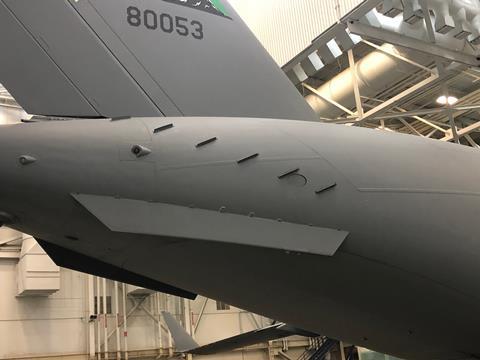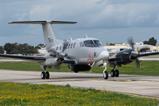The US Air Force (USAF) has outlined some of the efficiency gains it is pursuing for its air mobility fleet, with the service seeking to boost operational readiness and reduce its environmental impact.
“Our strategy in the air force is to maximise combat capability,” Roberto Guerrero, deputy assistant secretary of the air force for operational energy, told the Royal Air Force/Air and Space Power Association Global Air & Space Chiefs conference in London on 12 July.

“We are spending roughly $100-150 million each year over the next few years to test out technologies, and to get them on our platforms,” he says. Focus areas include initiatives to improve aerodynamic performance and reduce airframe drag.
“In some cases, 3D-printed fins that are glued to the side of our aircraft can give a 1-3% drag reduction,” Guerrero says. Examples include the addition of six ‘microvanes’ on each aft fuselage side of a Boeing C-17 strategic transport, which enable a 1% reduction in drag that the USAF estimates could save around $10 million and reduce greenhouse gas emissions by roughly 36,000t per year across the fleet.
A trio of ‘finlets’ attached to either side of a Lockheed Martin C-130 Hercules tactical transport near its cargo ramp can offer a 3-6% drag reduction, while an ‘air contour system’ installed on the Boeing KC-135 tanker’s aft fuselage also provides a 1% reduction.
“The application has to be fairly simple,” he says of such add-ons. “It has to require no maintenance, and it has to have some king of benefit to mission.”
Guerrero says the USAF also has worked in partnership with Delta Air Lines to explore the benefits of integrating other potential minor tweaks. “Something as basic as [installing] a vertical windscreen wiper will give us 1%,” he notes. Additional adjustments include re-rigging flight-control surfaces to eliminate deviation, and fitting an extra engine pylon faring on the C-17.
Once multiple such changes have been made, “you are getting close to a double-digit performance efficiency [gain],” he says.
Meanwhile, Guerrero says the USAF is also tackling larger-scale opportunities at the operational level, and cites as an example a digital mission planning advance implemented at Al Udeid air base in Qatar.
“We were using a whiteboard with dry-erase markers and magnets to schedule a 250-receiver and 50 tanker schedule, every day for 15 years, and nobody thought ‘hey, there’s a better way to do this’,” he says.
“Just by digitising it we got a 4% improvement, which is 200,000 gallons of fuel saved per week. Then by putting an algorithm in we were getting an extra 10% on top of that, so that’s close to a million gallons of fuel saved per week in one location – which is more air power for us in that location, or somewhere else.”
Guerrero notes that the USAF currently uses “close to 2 billion gallons of fuel per year… so we can make a pretty good impact on how much we spend on fuel by pulling these technologies in”.
“We see us burning liquid fuel for a long time to come, just because of the energy density,” he says. “We are going to be flight-following sustainable aviation fuel developments – we will be ensuring that what’s available to us includes those mixtures and [that they] are compatible with our platforms.”































